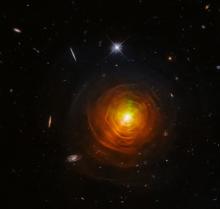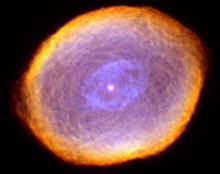Listen to today's episode of StarDate on the web the same day it airs in high-quality streaming audio without any extra ads or announcements. Choose a $8 one-month pass, or listen every day for a year for just $30.
You are here
VX Sagittarii
Sagittarius is home to some monster stars. That’s because one of the Milky Way Galaxy’s spiral arms passes through its borders. The arms are where new stars are being born, and some of those stars are especially big and bright.
One example is VX Sagittarii. It’s classified as a red supergiant or hypergiant. It’s probably a billion miles in diameter or bigger. That’s more than a thousand times the size of the Sun. It’s so big that if it took the Sun’s place, it would engulf the five closest planets.
The star has grown so puffy because it’s used up the original hydrogen fuel in its core. Now, it’s “burning” other elements. That raises the temperature of the core, so radiation pushes outward on the surrounding gas.
The process has made the star’s outer layers unstable, so it puffs in and out like a beating heart. Over a couple of years, its diameter varies by tens of millions of miles.
The star also produces a strong “wind.” It carries away enough gas to make a star as heavy as the Sun in just a few thousand years.
And before long, it’ll blow a lot more gas into space. The star will explode as a supernova. That’ll blast away its outer layers, leaving behind only its crushed core.
Sagittarius is low in the south at nightfall. Look for a group of eight stars that forms the outline of a teapot. VX Sagittarii is well above the teapot. It’s more than 5,000 light-years away, and it’s behind clouds of dust, so despite its brilliance, you need a telescope to see it.
Script by Damond Benningfield






